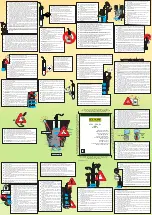
9
MAINTENANCE MANUAL MODELS 825Y, 825YA, 825, 825D, 825YD & 826YD
Field Testing Procedures
Purpose of Test
To test the operation of the DIFFERENTIAL PRESSURE RELIEF
VALVE and CHECK VALVE.
Equipment Required for Test
Differential Pressure Gauge test kit. Equal to the RPTK1 (shown
on page 13).
Test Differential Relief Valve
The Differential relief valve must operate to keep the zone
between the two check valves at least 2 psi less than the supply
pressure.
1. Slowly close the outlet shut-off on the discharge side of the
backflow preventer.
2. Open air bleeds and test cocks until all air from the check
valves is released.
3. Connect the “high” side of the differential pressure gauge to
test cock #2 and the “low” side to
test cock #3.
4. Open test cock #2 and test cock #3 and bleed all air from the
hose and gauge.
5. Slowly open the bypass valve needle #1 until the differential
gauge needle starts to drop. Hold the bypass in this position
and observe the reading on the gauge at the moment the first
discharge is noted from the relief valve. The differential pres-
sure at the time the relief valve opens must be no lower than
2 psi.
6. Close the bypass needle valve.
Test Check Valve 1
The check valve must be at least 3 psi more than the relief valve
opening pressure.
1. Open test cock #4 to flow a small amount of water through
the unit to restore normal pressures.
2. Observe the differential gauge with bypass valve #1 closed
and test cock #2 and #3 open. The gauge should remain at
a reading of at least 3 PSI above the relief valve. If it drops
below this, the check valve is leaking and must be serviced.
Test Check Valve 2
The check valve must be tight against reverse flow under all pres-
sure differentials.
1. Connect the “high” side of the differential pressure gauge to
test cock #4 (3rd hose).
2. Open test cock #4. With bypass needle valve #1 closed and
bypass valve #2 open, observe gauge reading. The differential
pressure should not drop to the relief valve opening point.
Restore Operation
1. Restore all valves and test cocks to their original positions.
Open and close resilient seated shut-offs slowly to prevent
damage to the system and assembly.
Figure No. 7
Figure No. 8
Differential Pressure
Gauge
Bypass
Needle
Valve #1
Test Cock
#2
Inlet
Shutoff
Value
Check Valve #1
Check Valve #2
Bypass Valve #2
Test
Cock
#3
Outlet
Shutoff
Value
Test Cock #4
Relief
Valve
FEBCO Model 825YD (2
1
/
2
–10")
Reduced Pressure Assembly
FEBCO Model 825Y (¾
–2")
Reduced Pressure Assembly
Test Cock #4
Bypass Valve #2
Differential
Pressure Gauge
Bypass Needle Valve #1
Test Cock #2
Test Cock #3
Test Cock #1
Inlet Shutoff
Value
Outlet Shutoff Value
Check
Valve #1
Check Valve #2
Test
Cock #1










































